Mental
By the beginning of the 20th century the County of Middlesex was in need of a new mental asylum. The population of the county had greatly expanded and its asylums at Wandsworth and Napsbury had become overcrowded. Napsbury Asylum had been extended but this was insufficient for the number of patients requiring admission from Harrow, Wembley, Acton, Willesden and parts of north London. The Middlesex County Council had chosen a site at Heston, but WW1 prevented its purchase and the project was held in abeyance.
In 1923 the Council again began the search for a suitable site and eventually decided unanimously on the Porters Park estate near Radlett. Although in Hertfordshire, it was chosen because of its proximity to the Middlesex County boundary and easy access to London from Radlett station, the estate was relatively isolated and rural (therefore the land was cheap). In 1924 the Council purchased it from its owner, a Mr C. Raphael.
Building work started on the new asylum in July 1931 but, in the meantime, three defunct aircraft hangars on the site were adapted for use as a temporary institution for mentally handicapped patients (which later became Harperbury Hospital).
The Shenley Mental Hospital was built in two stages in the villa design (instead of the corridor design, that is, large blocks with the wards leading off long central corridors). This design enabled many of the existing buildings on the estate to be incorporated into the Hospital - the mansion house, the walled garden (which provided fruit and vegetables for the kitchens), the coach houses and the stables. The first phase involved the building of the central administration buildings and recreation hall, with the main services - the kitchens, bakery, butcher's shop, stores, boiler house, engineering workshops and water tower - along a north-south axis. The laundry buildings were located at the back of the water tower and boiler house. Beside the recreation hall were two accommodation blocks for ancillary staff. The villas for 1046 patients were on an east-west axis - males to the east of the central block and females to the west. The construction work was completed on schedule at a cost of £520,000.King George V, accompanied by Queen Mary, officially opened the Hospital at the end of May 1934. The ceremony took place in the large recreation hall which could seat 1000 people (it was named King George V Hall after the event).
The second phase of building began in 1935 and was completed in 1938. The Hospital then had 2080 beds. The mansion house was adapted for use as a convalescent home for patients in 1937.
Each villa housed between 20 and 45 patients and had its own courtyard for patients' exercise. The sexes were kept strictly segregated, with 6 ft (2 metre) high railings surrounding nearly all the ward buildings. The wards were kept locked and nurses were provided with police whistles for emergency use, but spent most of their time carrying out domestic chores.
The Hospital was mainly self-sufficient, with its own water supply treatment and sewage works. The existing Shenleybury Farm had largely been rebuilt and patients were engaged in agricultural work as part of their therapy (it was believed that such outdoor occupation was healthy). They also worked the 22 acres of orchards situated variously around the Hospital grounds, picking and storing the fruit. The orchards provided produce for the Hospital kitchen as well as for the local market. Patients built the workshops, which would later provide occupations such as carpentry, cooking and arts and crafts. Female patients worked in the laundry, kitchens and wards. An Industrial Unit provided outwork for local industries. Patients were also trained in clerical work to provide employment skills on their discharge.
During WW2 many patients were discharged and half the Hospital became a military hospital for the treatment of wounded servicemen and civilians. The mansion house became a Nurses' Home. The Medical Superintendent, who lived in Porters Lea, was also the Colonel-in-Chief of the local Territorial Army unit. A gun emplacement was built at the edge of the cricket ground alongside Radlett Lane (and can still be seen today). An underground water reservoir was built near the gardener's cottage by the walled garden for emergency use in case of fire (it still remains and is used to irrigate the walled garden). The Hospital suffered some bomb damage. In September 1940 a land mine exploded just outside the grounds, while a second one failed to explode as its parachute had become entangled in an oak tree by the boiler house. During the war the Hospital took all female admissions from the Napsbury Hospital catchment area in north Middlesex, to relieve overcrowding.
In 1948 the Hospital joined the NHS under the control of the North Western Metropolitan Regional Hospital Board. In 1950 it had 2051 beds.
By 1953 the Hospital had 2370 patients. However, post-war developments and changes in attitudes towards mental disease began to improve life for the inmates. The iron railings were removed from most of the villas and the doors to the wards unlocked. Patients were free to come and go as they wished. (Two wards - MA1 and Villa 4 - remained secure, for patients who were considered dangerous to the public.) Shenley was one of the first mental hospitals in England to introduce mixed dances for staff and patients in the King George V Hall. Cinema shows and other entertainments were held in the Hall. Coach trips to places of interest were also introduced. By this time there was a shift away from institutionalized care, and the number of patients declined.
The Hospital gained a reputation of being highly progressive in the field of psychiatry. It became one of the leading centres for psychiatric training and practice, instigating modernization of mental health care.
The Hospital farm closed during the 1960s as part of government policy that hospital farms should cease - it was frowned on that patients should be used to maintain the institution. The orchards fell into disuse.
While some of the Hospital facilities were shared by both patients and staff, the staff enjoyed additional facilities for their use alone - an art centre, a Social Club, swimming pool, squash courts (behind the mansion house), a football pitch and a cricket ground (the cricket team was considered the best in the London hospital area). The Social Club held dances and events almost every night and was considered the heart of all social activities within the Hospital during the 1960s and 1970s.
In 1974, following a major reorganisation of the NHS, the Hospital came under the control of the Brent and Harrow Area Health Authority, part of the North West Thames Regional Health Authority. It had 1400 patients.
In 1982, when the Area Health Authorities were abolished, it transferred to the Brent District Health Authority.
By 1986, as the policy of 'care in the community' began to be applied, there were only 900 patients in the Hospital. Gradually, patients were moved to smaller hostels or sheltered accommodation nearer their own communities as the large mental hospitals emptied out.
In 1992 the Hospital became the responsibility of the North West London Mental Health NHS Trust. Patient numbers continued to decline and, in tandem with this, staff numbers. This affected use of the Social Club, which closed in April 1994.
By 1998 only one ward remained open, home to mainly elderly patients awaiting resettlement in a hostel within the community. Their move had been delayed because of a protest by residents who did not want a mental health residence in their area. While the patients waited for the dispute to be settled, demolition began of the other ward buildings. The Hospital finally closed later in the year.
Present status (September 2008)
During the Hospital's gradual closure, plans were made to create a new rural park within its grounds. The Shenley Park Trust was formed in 1992 to manage and develop the park. One of its first actions was to restore the overgrown orchards, which now contain over 400 apple trees, with 90 different variaties.
The Hospital buildings have mostly been demolished, but the mansion in Grace Avenue, the chapel, Orchard Villa and the water tower remain. The Engine House has been converted into architects' studio offices.
The Orchard Tea Room was built on the site of the Hospital's Social Club in 2000.
Nearly 900 new residences have been built on the site.
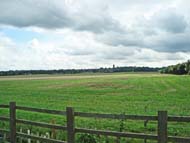
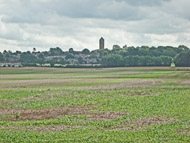
Shenley Hospital's water tower can be seen in the distance from Harper Lane (above) and Harperbury (below).

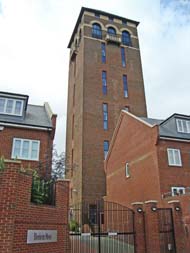
The Italianate water tower, built in 1932, was sold to private developers who converted it into 6 duplex apartments in 2005.

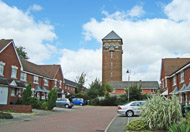
The water tower is surrounded by new housing, the gated Blenheim Mews development.
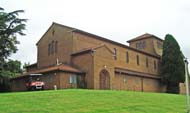
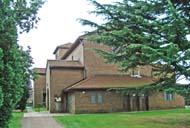
The Hospital's chapel also survives.
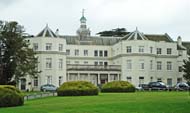
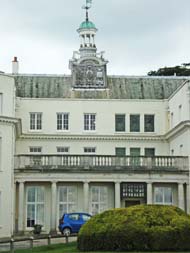
The Grade II listed Porters Mansion in Grace Avenue was once the home of the architect Nicholas Hawksmoor.
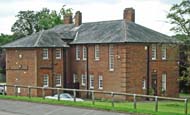
Orchard Villa, once one of the ward blocks, is now used for serviced offices.
In the early 1960s the South African-born Dr David Cooper, the most radical psychiatrist, coined the phrase 'anti-psychiatry'. The anti-psychiatrists experimented with institutional alternatives.
In 1962 Cooper set up an experimental ward for schizophrenic patients in Villa 21 at the Hospital. The purpose of the ward was to destructure the ward environment. There was to be no distinction between patients and staff, who wore no uniforms.
Cooper tried to create a community in which the patients would have a chance to discover and explore an authentic relatedness to each other. This required them to make "an effort to cease interference, to 'lay off' other people" and give them and themselves a chance. It was necessary to allow patients to 'go to pieces' before they could be helped to come back together again. Patients and staff sought to deal with emotional problems through non-responsive involvement.
By 1966 it was deemed that the experiment had failed. The patients, left to their own devices, followed their own routines. Staff controls had to be reintroduced to restore some semblance of order on the ward. The new regime had not changed the ward staff's role-bound behaviour and Cooper concluded that a successful unit could be developed only in the community, outside of a hospital environment.
Cooper D 1967 Psychiatry and Anti-psychiatry. London, Tavistock Publications.
www.dbdouble.freeuk.com
www.soteria.freeuk/com
Chaplin R, Peters S 2003 Executives have taken over the asylum: the fate of 71 psychiatric hospitals. Psychiatric Bulletin 27, 227-229.
North West London Mental Health NHS Trust 1998 Shenley Hospital 1934-1998. Shenley Hospital, North West London Mental Health NHS Trust.
Wilson B 2000 Goodbye Asylum: The Last Ward at Shenley Hospital. London, Headless Photos.
http://archaeologydataservice.ac.uk
http://pb.rcpsych.org
www.aim25.ac.uk
www.bbc.co.uk
www.countryasylums.com
www.flickr.com
www.geograph.org.uk
www.hertfordshire-genealogy.co.uk
www.hertsmemories.org.uk
www.infopool.org.uk
www.insidestories.org
www.oldukphotos.com
www.shenleypark.co.uk
www.shenleyvillage.org
www.stalbansoutofsightoutofmind.org.uk
Return to home page